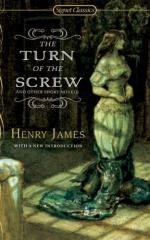|
This section contains 4,738 words (approx. 16 pages at 300 words per page) |

|
SOURCE: “Narrative Games: The Frame of The Turn of the Screw,” in Journal of Narrative Technique, Vol. 28, No. 1, Winter, 1998, pp. 43–55.
In the following essay, Williams analyzes the frame of the story, contending that it evokes “a heightened story-world.”
The Turn of the Screw has been the site of a long-standing and seemingly intractable critical controversy. What Bruce Robbins ironically calls “The Thirty Years' War” (“shooting” 192) proceeded up to the 1970s over the pivotal question of whether the governess really sees the ghosts—taking her at her word, so it is a ghost story and an entertainment—or whether she hallucinates—taking her as unreliable, innocently due to her youth and inexperience or to her sexual repression and confusion, or more ominously due to her mental disorder or her manipulative scheming. Most early (pre-New Critical) readings see the novel unproblematically as a ghost story, after the manner of the...
|
This section contains 4,738 words (approx. 16 pages at 300 words per page) |

|


